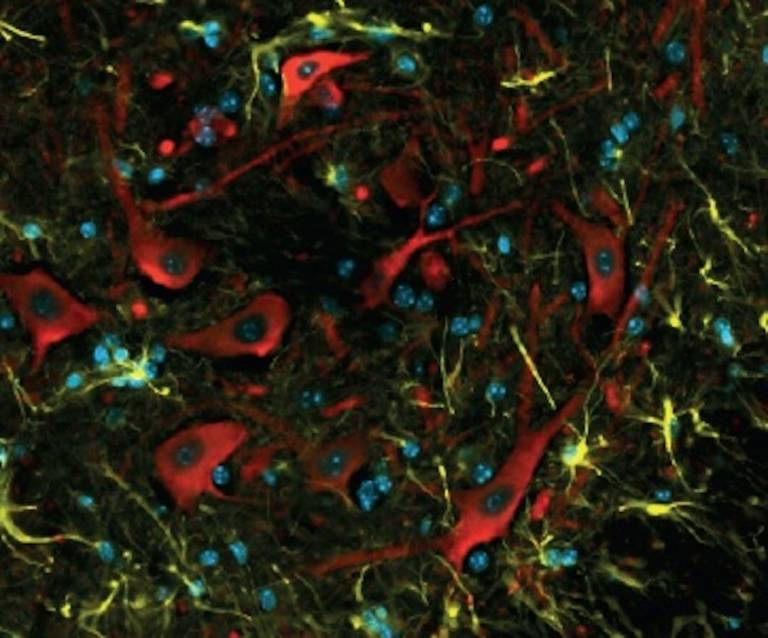Protective response to early changes in ALS and FTD
29 February 2024
A new study led by Professor Adrian Isaacs (UCL Queen Square Institute of Neurology and UK DRI at UCL) provides fresh insight into early changes that occur in the brains of people with ALS and FTD, and reveals a response in cells that protects against neurodegeneration

The research, published in Nature Neuroscience, could identify new therapeutic avenues to treat the diseases amyotrophic lateral sclerosis (ALS) and frontotemporal dementia (FTD).
What was the challenge?
A mutation in a gene called C9orf72 is the most common cause of ALS and FTD. This faulty gene leads to the production of abnormal proteins which are a known feature of the diseases, but their impact has not yet been fully determined. In this study, the team set out to generate a new mouse model which more accurately recapitulated the pathology of the disease to examine the impact of these proteins in the brain and spinal cord.
What did the team do and what did they find?
With funding from the Motor Neurone Disease Association, the UK DRI and the Packard Center for ALS Research, the researchers created mouse models with a specific genetic makeup that mimicked features of ALS and FTD. When they studied the proteins found in the spinal cord of the mice, they discovered an increase in proteins related to the extracellular matrix , which usually provides structural support to cells – with levels of a protein called COL6A1 most raised.
Further investigation revealed that a protein called TGF-β1 played a key role in controlling this increase in extracellular matrix proteins. When the scientists experimented with this in human neurons grown in the lab, they found that the abnormal proteins generated by faulty C9orf72 triggered the production of TGF-β1 and COL6A1.
To understand the impact of these findings on the disease, the team conducted experiments in fruit flies and human neurons. They discovered that reducing TGF-β1 or COL6A1 caused neurodegeneration to worsen in fruit flies, while increasing these proteins protected human motor neurons from certain types of damage – suggesting that the proteins could be triggering a protective response in cells.
What was the impact of these findings?
The new model provides insight into early changes that occur in the brains of people with ALS and FTD. It could help to identify new therapeutic avenues to treat these diseases.
Senior author Prof Adrian Isaacs, Group Leader at the UK DRI at UCL, said: “I am delighted that this collaborative effort has come to fruition. We unexpectedly found that neurons can mount a neuroprotective effort early in the course of FTD and ALS. This provides important new information in our fight to understand and ultimately develop treatments for neurodegenerative diseases. ”
Co-senior author Prof Elizabeth Fisher, Professor of Neurogenetics at UCL Queen Square Institute of Neurology, said: “These new mouse models have taken many years to make and characterise, with funding from UK and USA, and they will greatly help our efforts to understand why motor neurons die as a result of mutation in the C9orf72 gene.”
Carmelo Milioto, first author, Honorary Research Fellow, Department of Neurodegenerative Disease, UCL Queen Square Institute of Neurology: "I am glad these new mouse models will help the scientific community to understand motor neuron pathology onset and progression in motor neuron disease and frontotemporal dementia. I am enthusiastic about this achievement that finalises years of studies with several collaborators in UK as well as abroad."
Links
- Milioto, C., Carcolé, M., Giblin, A. et al. PolyGR and polyPR knock-in mice reveal a conserved neuroprotective extracellular matrix signature in C9orf72 ALS/FTD neurons. Nat Neurosci (2024). doi.org/10.1038/s41593-024-01589-4
- Professor Fisher's academic profile
- Professor Adrian Isaacs' academic profile
- Dr Milioto's academic profile
- Queen Square Motor Neuron Disease Centre, UCL Queen Square Institute of Neurology
Source
Banner image credit: Mireia Carcolé
 Close
Close

